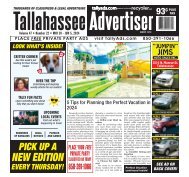050120_layout_AllPages
You also want an ePaper? Increase the reach of your titles
YUMPU automatically turns print PDFs into web optimized ePapers that Google loves.
THETRUCKER.COM<br />
Louisiana-born Ted Daffan (1912-1996) had<br />
already made his mark as a singer/songwriter in<br />
southeast Texas when he pulled into a roadside<br />
diner one evening in 1938.<br />
Little did he know the diner would inspire a<br />
new song — a short, simple tune that would make<br />
Daffan a pioneer of a new category of American<br />
music. Historians agree that when Ted Daffan<br />
went home and penned the lyrics to “Truck<br />
Driver’s Blues,” he gave birth to “truck-driving<br />
music,” a genre that lives on 82 years later.<br />
The irony of the background to “Truck Driver’s<br />
Blues” is that Daffan’s simple observations<br />
and simple lyrics satisfied the needs of a society<br />
in the grips of the Great Depression, a society for<br />
which simplicity was a luxury. In the process, the<br />
song also made Ted Daffan quite wealthy for a<br />
musician of the time.<br />
After graduating from Lufkin (Texas) High<br />
School in 1930, Daffan taught himself to play the<br />
Hawaiian guitar, the metallic sound of Hawaiian<br />
music catching his ear. By 1933, he played well<br />
enough to land a spot with The Blue Islanders,<br />
a band with a regular radio show on Houston’s<br />
KTRH. When The Blue Islanders folded, he<br />
played with other bands such as The Blue Playboys<br />
and The Bar-X Cowboys, signaling a movement<br />
toward western swing.<br />
Daffan held an interest in electronics, particularly<br />
how they could be used to improve instrumental<br />
music. During the 1930s, he experimented<br />
with amplified guitars and operated a shop in<br />
Houston specializing in electrical instruments. By<br />
the end of the decade, Daffan and his amplified<br />
steel guitar blazed a new trail in western swing,<br />
a style of music previously known for its use of<br />
twin fiddles. The steel guitar put the “twang” in<br />
western swing — and eventually in mainstream<br />
country music. Today the instrument is regarded<br />
as one of most difficult to master.<br />
But Daffan was ahead of his time.<br />
Daffan considered himself a songwriter first<br />
and a performer second. “Truck Driver’s Blues,”<br />
the song for which he is arguably best remembered,<br />
took shape two years before he began a<br />
serious recording career. Daffan turned to fiddleplaying<br />
bandleader Cliff Bruner with his song,<br />
hoping Bruner and his Texas Wanderers could<br />
make it suitable for airplay. Likewise, Bruner had<br />
a contract with Decca Records, the label that gave<br />
Bing Crosby his break in the music business.<br />
History proves Daffan made a wise choice.<br />
The story of “Truck Driver’s Blues” is almost<br />
too perfect to be anything but legend, but it is a<br />
story music historians repeat as factual. Daffan’s<br />
stop at the unknown roadside café, perhaps a<br />
precursor to the truck stops of later years, gave<br />
him the chance to observe several truck drivers.<br />
As Daffan waited for his meal he watched, as one<br />
after another, the drivers parked their rigs and<br />
Perspective May 1-14, 2020 • 11<br />
Ted Daffan: Musical pioneer satisfies<br />
society’s simple needs with simple song<br />
Kris Rutherford<br />
krisr@thetrucker.com<br />
Rhythm of<br />
the Road<br />
entered the diner. Before sitting down, every<br />
driver stopped at the jukebox, put in a couple of<br />
nickels and hung around to hear a favorite tune.<br />
Realizing that Depression-era truck drivers<br />
willingly spent five or 10 hard-earned cents<br />
on something as simple as a song gave Daffan<br />
an idea. What would truck drivers pay if one of<br />
those songs in the jukebox focused on the drivers<br />
themselves? As the story goes, Daffan saw dollar<br />
signs — or at least a lot of nickels — all destined<br />
for his pockets.<br />
A few hours later he penned what would become<br />
the first truck-driving song. When the Texas<br />
Wanderers recorded “Truck Driver’s Blues” in<br />
early 1939, it was an instant success. In the early<br />
days of country music, a major hit sold about<br />
5,000 copies. Released on the Decca Records label,<br />
“Truck Driver’s Blues” was not only the top<br />
selling record of 1939, but it also sold a staggering<br />
100,000 copies. Ted Daffan had indeed struck<br />
a chord with a new audience, and in the eight<br />
decades since, many songwriters and performers<br />
have made their marks on music following Daffan’s<br />
lead.<br />
“The blues” had been around a lot longer than<br />
Ted Daffan. In the first few decades of the 20th<br />
century, the blues, a music genre thought to have<br />
originated in Africa, became mainstream. The<br />
Great Depression was a period when most Americans<br />
had a case of the blues, and the songs of the<br />
1930s are nothing less than a musical history of<br />
the years of poverty. Whether the blues performers<br />
sung of breadlines, tax collectors, the Dust<br />
Bowl, prohibition, Wall Street, milk cows or perhaps<br />
the most collective, “The All In and Down<br />
and Out Blues,” the songs struck the collective<br />
nerve of society. Daffan recognized the same look<br />
of “the blues” in the faces of truck drivers.<br />
More than 80 years after The Texas Wanderers<br />
recorded “Truck Driver’s Blues,” the lyrics<br />
are just as applicable as they were in 1939. Drivers<br />
of the 21st century may travel America on<br />
controlled-access highways designed for speed<br />
rather than the winding two-lane roads following<br />
pig trails of days gone by, but the worries of yesteryear<br />
remain alive in the trucking industry.<br />
Like many blues-related songs, “Truck Driver’s<br />
Blues” begins with a familiar line of misery,<br />
“Feelin’ tired and weary.” Beyond those opening<br />
words, however, Daffan sums up the life of a<br />
truck driver in just three short phrases:<br />
“Keep them wheels a-rolling, I ain’t got<br />
no time to lose.<br />
There’s a honky-tonk gal a waitin’ and<br />
I’ve got troubles to drown.<br />
Never did have nothin’, I got nothing<br />
much to lose — just a low-down feelin’, truck<br />
driver’s blues.”<br />
Those sentiments, the same truck drivers have<br />
today, are what “Truck Driver’s Blues” put to<br />
music — no time to lose, troubles to drown and<br />
nothing left to lose (other than the blues).<br />
“Truck Driver’s Blues” is a simple song written<br />
in simple times. And as Daffan discovered<br />
after an evening in a roadside café, satisfying<br />
Americans’ simple desires through simplicity itself<br />
can be lucrative — and groundbreaking.<br />
Until next time, when you’re feeling tired and<br />
weary, stay safe and pull off the highway. Staying<br />
safe can keep the blues at bay. 8<br />
MOVINGFORWARD<br />
ALWAYS<br />
Mercer Transportation prides itself on<br />
being one of North America’s safest, most<br />
dependable, carriers. If you’re ready to join<br />
our team of hard-working contractors, we<br />
provide load coordinators and personalized<br />
support to help you succeed in your business.<br />
We’ve been trucking since the 70’s, and<br />
Mercer is still growing. Thousands of<br />
independent contractors enjoy the benefits<br />
of working with a national trucking company,<br />
including discounts on fuel and gear. Pick the<br />
loads you want to haul and get paid fast.<br />
Make 2020 a new beginning and keep your<br />
business moving forward. Join the team at<br />
Mercer Transportation.<br />
855-866-4312<br />
MERCERTOWN.COM E<br />
100% OWNER OPERATOR<br />
WITH PRIDE,<br />
INTEGRITY<br />
&<br />
YOU!<br />
40 + YEARS

















